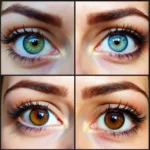Iridescence is not a color in the traditional sense, but rather an optical phenomenon. It’s the way certain surfaces appear to shift in color as the angle of view or the angle of illumination changes. Think of a soap bubble or the feathers of a peacock – their shimmering, shifting colors are a classic example of iridescence.
Understanding the Science Behind Iridescence
So, if it’s not a color, what is it? Iridescence is caused by the interference of light waves reflecting off multiple layers of a surface. These layers are thin and transparent, and when light hits them, some light reflects off the top layer, while some penetrates and reflects off lower layers. These reflected waves can either interfere constructively (enhancing each other) or destructively (canceling each other out), creating the shimmering effect we perceive as iridescence. The specific colors we see depend on the thickness of the layers and the angle of the light. This is why the colors seem to shift and change as you move or the light source changes. Think of it like a natural prism, splitting light into its constituent colors.
 Peacock feathers showing iridescent colors Have you ever wondered [what color is peacock]? Their mesmerizing feathers are a prime example of this phenomenon.
Peacock feathers showing iridescent colors Have you ever wondered [what color is peacock]? Their mesmerizing feathers are a prime example of this phenomenon.
Iridescence in Nature and Design
Iridescence isn’t just a scientific curiosity; it plays a vital role in the natural world, particularly in the animal kingdom. Many birds, insects, and fish display iridescence, using it for camouflage, communication, and attracting mates. The brilliant colors of a hummingbird’s throat or the shimmering scales of a [what color is scarab] beetle are all examples of iridescence in action.
[what color are crows]? While not as vibrantly iridescent as peacocks, crows can display a subtle iridescent sheen on their feathers in certain lighting conditions.
In the world of design, iridescence is used to add a touch of magic and intrigue. From iridescent fabrics and paints to shimmering makeup and nail polish, this optical effect adds a dynamic and eye-catching element to various products and creations. Ever seen a shimmering dress or a car with a pearlescent finish? That’s the magic of iridescence at work.
Is Peacock a Color?
While we often describe the color of a peacock as “peacock,” it is not a single, distinct color. Rather, it’s a complex interplay of iridescent blues and greens, created by the microscopic structure of the bird’s feathers. You can learn more about this on our page about [is peacock a color]. Similar to the question [what color is shimmer and shine], the answer often involves a combination of colors and effects rather than a single color name.
How Is Iridescence Different from Metallic Colors?
While both iridescence and metallic colors involve light reflection, they differ in their underlying mechanisms. Metallic colors are created by the reflection of light off a smooth, opaque surface, often containing metallic particles. This results in a single, consistent color, unlike the shifting hues of iridescence.
Creating Iridescence
Creating iridescent effects involves manipulating the structure of a material to create the necessary thin, transparent layers. This can be achieved through various techniques, including layering different materials, applying specialized coatings, and using diffraction gratings.
Can You Paint Iridescence?
Yes, there are special iridescent paints available that mimic the natural phenomenon. These paints contain tiny particles that interfere with light, creating a shimmering effect.
Conclusion
Iridescence isn’t a color itself, but a breathtaking optical phenomenon that creates a mesmerizing display of shifting colors. From the natural world to the world of design, iridescence adds a touch of magic and beauty to our lives. Understanding the science behind this fascinating effect allows us to appreciate its wonder even more. So, next time you see a shimmering butterfly or a rainbow-hued soap bubble, remember that you’re witnessing the magic of iridescence.
Need help with color selection or creating an iridescent design for your space? Contact us! Phone: 0373298888, Email: [email protected], or visit us at 86 Cầu Giấy, Hanoi. We have a 24/7 customer service team ready to assist you.
